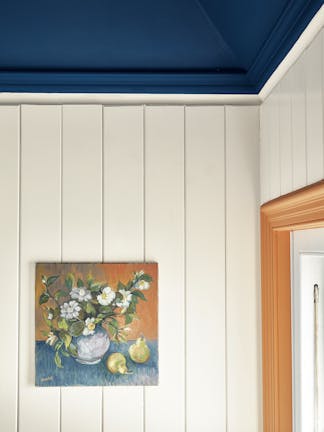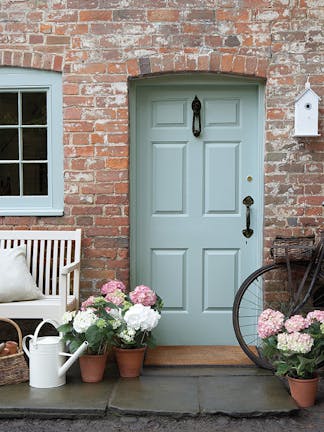Painting the inside of a wooden window frame can be a trickier job than you think. It’s easy to make a mistake and paint over pre-decorated walls, or spill onto the window itself. There’s also the dreaded carpet-drip you’ll need to steer clear of - painting a frame is not an easy task for amateur decorators, but (as always!) the right tools and preparation will help you achieve a high quality finish.

At Little Greene, we offer water-based finishes in eggshell (low sheen), satin (mid sheen) and gloss (high sheen). ‘Intelligent Eggshell’ (15%) and 'Intelligent Satin' (30-35% sheen) are our most popular choices for interior woodwork – they have a very smart, low-sheen finish and are water-based, but formulated to behave like an oil paint - to resist wear and tear and, crucially, moisture.
Wall: Flint
Ceiling: Deep Space Blue
Window Frame: Marigold

Before you get started, ensure that you have protected any areas you don’t want to paint, using masking tape. This includes catches, hinges and handles – you might consider removing them completely. Give all the surfaces (including the glass) a thorough clean before you get going, removing the likelihood of dirt, grime or dust being mixed into your paint.
If the surface is previously painted and in sound condition, simply rub down with sandpaper to prepare the surface. If painting new wood, you will need to use the appropriate primer undercoat, and if the surface is flaking or powdery you will need to strip it right back – the new painted surface will only perform well if the one underneath it is sound.
Using a good quality tape that won’t allow the paint to bleed underneath, tape the edges of the windowpane flush with the edge of the frame.
Look at the area around where you will be painting. Cover the carpet and the wall directly below the window if you can. This can save time and money, especially if you no longer have leftover paint to touch up your walls.
Lower Wall: Pale Lime
Upper Wall: Brighton
Window: Loft White

With a good quality brush at the ready (one that won’t lose bristles and can maintain a flat edge – an angled brush is good), stir your paint, ensuring consistency throughout the tin. It’s good practice to decant some of the paint into a separate container and reseal the tin (it prevents the paint in the tin from evaporation or being contaminated) and start your coverage of the horizontal rails.
Some windows won’t have horizontal or vertical cross-pieces (known as bars, rails and/or muntins), but if yours does, make sure all the glass panes are all taped. Painting from the centre outwards is a good technique for maintaining control, and concentrate on keeping your brushstrokes long and consistent. With detailed work like this, you will need to pay special attention to avoid drips from the edges and pooling in the corners. Next, move onto the outside frame.
Wallpaper: Pomegranate - Bazaar
Window & Units: Citrine
Ceiling: Portland Stone – Pale
Far Cabinets & Baseboard: Portland Stone

You may need to switch to a smaller brush for the underneath of the window sill; paint from the wall outwards. Finish on the top surface of the sill and, leaving everything where it is, let the window dry in a well-ventilated environment.
Note that if it’s windy outside, opening the window is not necessarily the best way to provide ventilation – drying paint is vunerable to loose particles in the air.
The tape should only be removed when fully dry; run a sharp knife blade along the edge to of the tape to ensure a really crisp result.
Door and window frame: Celestial Blue
Bench: French Grey
Bird house: Shirting
Watering can: Slaked Lime

